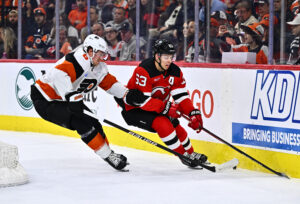Over the last several months, I have been crunching numbers, trying to solve the many questions of player development. With that, we here at Last Word On Hockey will be starting a new series on how to properly develop NHL prospects from all different spots throughout the draft.
How to Properly Develop NHL Prospects
From 2005-2015, there have been 24 draft picks used on forwards from North American junior teams. The focus was directly on North American prospects for the sake of comparing stats. I separated those 24 forwards from the rest of the top-three-picked NHL prospects in that span. Then, I looked at their DY-1 stats, the season before they get drafted, and their DY stats. I averaged out their points per game in their DY-1, DY and beyond, if necessary, and color-coded them. The four sections were “well-above average,” “above average,” “below average” and “well-below average.”
Based on the sections they landed on before they played 15 or more games in an NHL season, they were separated into categories. The categories for NHL prospects were “Forwards deemed NHL Ready,” “Forwards nearly NHL Ready,” “Slightly Rushed,” “Rushed,” “Forced,” “Teams were Patient,” and “Teams were way too patient.” Only three players in the span listed above landed in the NHL Ready section. Those three were Connor McDavid, Sidney Crosby, and Patrick Kane. All three posted well above average in their DY-1 and DY seasons.
Player Development of McDavid, Crosby, Kane
For McDavid, Crosby and Kane, they were absolutely dominant forces in juniors. They posted 1.768, 2.288, and 1.581 points per game, respectively, in their DY-1. Kane was in the USDP that season, so it could be argued that he was not as dominant. However, he moved to the OHL and dominated alongside the other two listed in CHL dominance. In their DY’s they posted 2.553, 2.71 and 2.5 points per game, respectively.
All three NHL prospects made the NHL directly following their selection in the draft. Just because they made it doesn’t mean player development stops there. How did they get utilized in their first three years, with those years being pivotal in their development? Ice time? Games played? The whole nine yards.
Player Development, How were they used?
Connor McDavid
In McDavid’s rookie season, he went down early with a shoulder injury. Most who are reading this will remember what happened. He finished the year having played 45 games, posting 16 goals and 32 assists for 48 points. He averaged 18:53 time on ice per game. For the more advanced group out there, here are his analytics: 9.6 even-strength offense (EVO), -1.2 even-strength defense (EVD), 2.6 wins above replacement (WAR), and 13.2 goals above replacement (GAR). Other than his EVD, McDavid posted remarkable numbers.
In McDavid’s second season, he played a full 82 games, posting 30 goals and 70 assists for 100 points. He averaged an insane 21:08 time on ice per game. His role increased by a few minutes every game, a considerable raise for a youngster. McDavid was also able to remain healthy and dominate the league. Analytically, he went up to a 19.7 EVO, 0.9 EVD, 6.3 WAR, and a 33.6 GAR. What was an incredible rookie season was trumped by his sophomore year.
Finally in his third season, McDavid played another full 82-game season, recording 41 goals and 67 assists for 108 points. He averaged even more time on ice per game then last year, with a 21:33 mark. Analytically, McDavid posted a 22.9 EVO, -6 EVD, 4.5 WAR, and a 23 GAR. His numbers went down in all but his EVO rank, with his EVD notably plummeting. But again, McDavid absolutely crushed the league yet again.
Sidney Crosby
In Crosby’s rookie season, back in 2005-06, he played 81 out of 82 games. He scored 39 goals and 63 assists for 102 points. He averaged 20:08 time on ice per game, which is absurd for any forward, never mind a rookie. Unfortunately, at the time, advanced analytics were not being gathered. But it’s clear, putting his numbers to McDavid’s sophomore year, that it would be similar analytically.
In Crosby’s second season, he played in 79 games, recording 36 goals and 84 assists for 120 points. He averaged slightly more time on ice per game, with a 20:46 mark. Yet again, those above analytics were not yet gathered. Based upon his raw stats, you could assume Crosby would have had a better season than all three of McDavid’s.
In Crosby’s third season, he was limited to just 53 games played. Despite the limitations, Crosby recorded 24 goals and 48 assists for 72 points. He continued to gain a raise in ice time, finishing with an average of 20:51 per game. Luckily, his third season was the first year where analytics were gathered. Crosby recorded a 11.6 EVO, 0.3 EVD, 4 WAR, and a 22 GAR. His EVO didn’t come close to any of McDavid’s numbers after McDavid’s rookie season, but that could be blamed on injuries holding him back.
Patrick Kane
In Kane’s rookie season, he played in a full 82 game season, recording 21 goals and 51 assists for 72 points. He played an average of 18:22 time on ice. This means he averaged the smallest role in any of the aforementioned seasons that Crosby and McDavid averaged. He posted a 6.2 EVO, -0.2 EVD, 2.4 WAR and a 13.3 GAR. Those numbers are almost identical to that of McDavid’s, but being slightly below him in EVO and point per game numbers.
In Kane’s sophomore season, he played in 80 of 82 games, recording 25 goals and 45 assists for 70 points. He averaged 18:40 time on ice per game, a slight raise from his rookie year. Additionally, he posted a 0.9 EVO, a -1 EVD, 1.3 WAR, and a 7 GAR. Despite his struggles, the Blackhawks did not take away his role that he owned in his rookie season, even giving him a bump in ice time. It was a show of trusting the process from the Hawks.
Finally, in Kane’s third season, he played 82 games and scored 30 goals and 58 assists for 88 points. His role expanded even further, averaging 19:12 of ice time per game. He also recorded an 11 EVO, 0 EVD, 3.6 WAR, and a 19.9 GAR. Despite a poor analytical showing in year two, Chicago went out of their way to give their franchise cornerstone a massive role yet again, and this time he ran away with it. Another show of letting it all play out, paying off.
Player Development for McDavid, Kane and Crosby
It’s hard to mess up when you have potential franchise cornerstones fall into your laps. But for the Edmonton Oilers, Chicago Blackhawks and Pittsburgh Penguins, they still played a big role. They took these young kids who dominated the lower-levels of hockey and gave them a big role immediately. Through struggles, injuries and other factors, they stuck to their paths and kept giving these players bigger and bigger roles.
In the case of these three phenomenal NHL prospects, Kane had the smallest role, while McDavid had the biggest (purely due to Crosby’s early injuries). Based on per 60 rates over the course of their careers, or from 2007 to present, McDavid has the highest EVO/60 rate, with Kane being last. Crosby has the highest EVD/60, with McDavid coming in last. McDavid also finished first in both WAR/60 and GAR/60, with Kane finishing last in both. While it can’t be totally pointed towards roles played in their first three years, there is a correlation here. Not to mention, there is a clearer connection in the future pieces, so stay tuned!
Main Photo:






